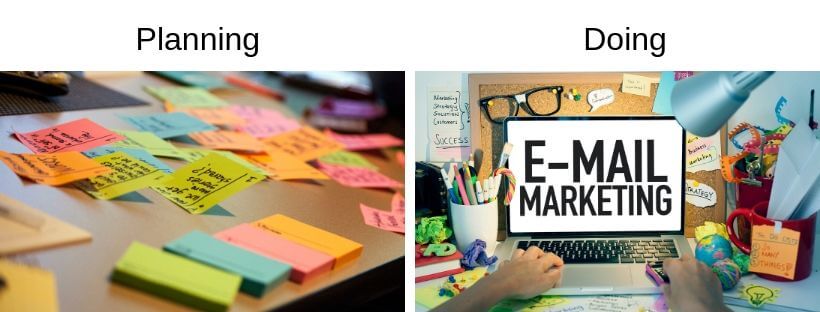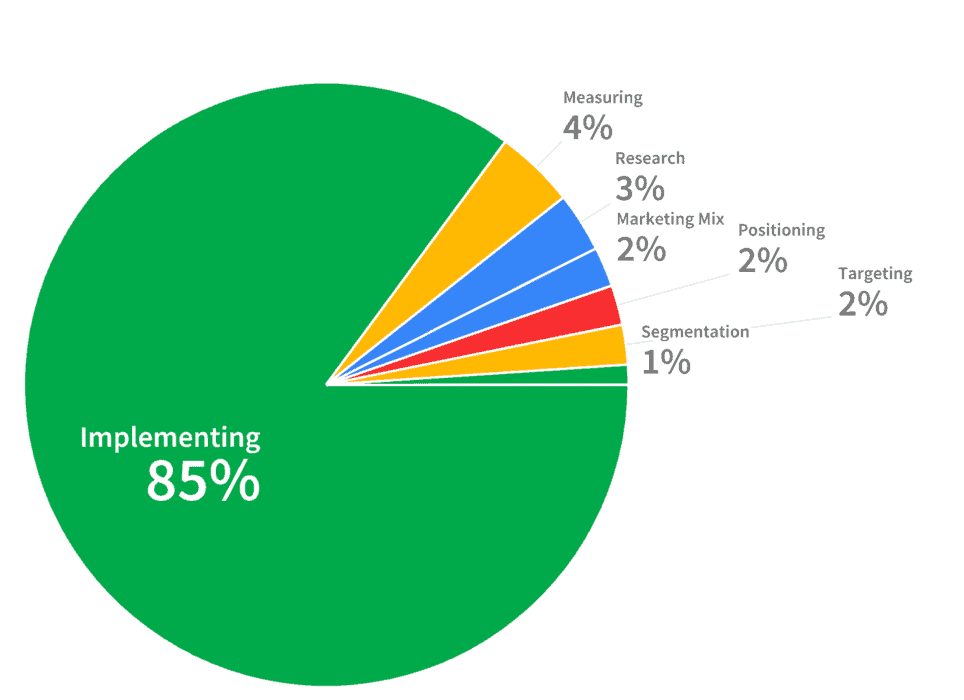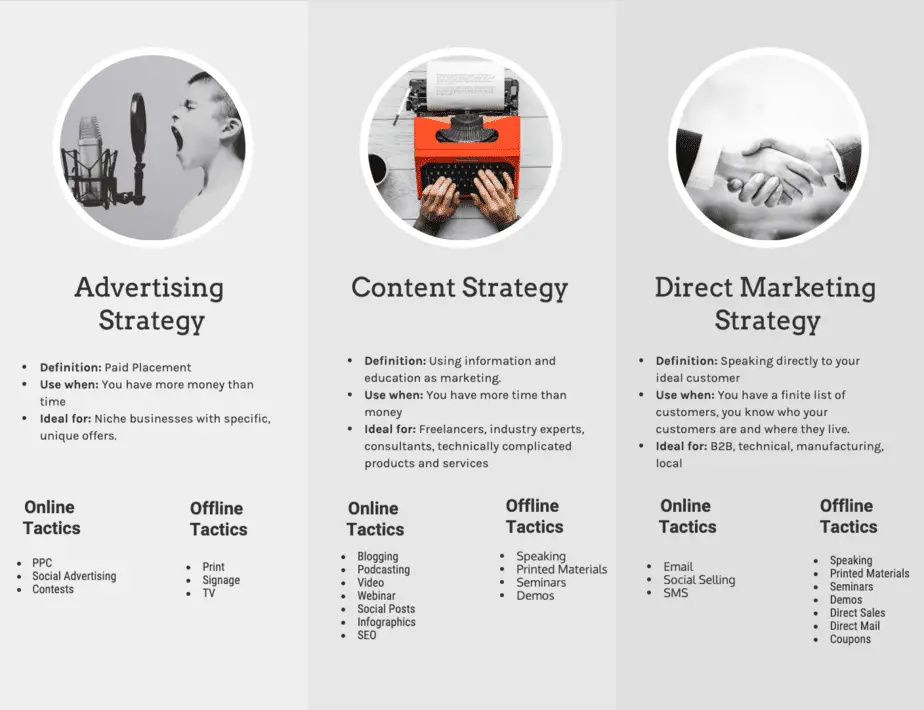How many times have you heard “To get more customers, you have to map out your marketing process”, or how about “Automate your marketing process”? Everyone just assumes that you know what a marketing process is and that automating it should be a breeze with the right tool. UGH!
This is the equivalent of saying, to get to the moon, you have to build a rocket! And while you’re at it — get some robots to build your rocket.
REALLY? REALLY?
Thank you, marketing expert. I know I need a marketing process — like I know a rocket will get me to the moon. But how do I get one of those – assuming I’m not a rocket scientist or marketing expert?
A Map of the Marketing Process: Planning vs Doing
In this article, I’m going to simplify this whole “what is a marketing process” question and show you how to map out a marketing process for your business — in plain English.
What is a marketing process and why does it matter?
A marketing process is a series of steps you take to identify opportunities, define customers and select a strategy to attract leads and convert them to customers.

There are really two aspects to the term “marketing process”; the planning side and the doing side.

The 5 Steps of the Marketing Process
I like to think of the marketing process more like a recipe; you have to do all the steps in order. If you skip any step, or if you don’t complete each step, your output will fail. In other words, your marketing campaign isn’t going to generate the results you’re after.
These are the sequential steps that you take when you are creating your marketing plan.
- Market research: What’s missing in my industry? What problems am I uniquely qualified to solve?
- Ideal customer: Who is my ideal customer, what is their desired outcome, what’s their biggest challenge?
- Offer: What is my irresistible offer? The irresistible bundle of product, service, price, promotion and distribution? This is really the 4 P’s; Product, Price, Promotion, Place.
- Implement your strategy: Where will my customers come from? Your choices are: Content marketing, Direct Marketing and Paid advertising. This is the DOING part. All you need to decide here is WHICH of these three marketing strategies are you going to DO.
- Measure your results: This element doesn’t need to be fancy. It can include something as simple as counting phone calls or as complex as tracking Google Analytics.
It’s a step-by-step process which means that you complete one step before you move on to the next step.
When you follow each step your marketing will be on a solid foundation. The answers to your questions will be self-evident and you will reduce the amount of time, money and risk associated with your overall marketing.
Planning your marketing doesn’t have to take months and result in a 500-page document. A solo-preneur can spend between a day and a week. A business with 10 employees or less can spend from a week to a month. These days, there is very little reason to spend more than 30 days planning your marketing.
You can use this One-Page Marketing Plan template to start the planning part of your marketing process.
None of this has anything to do with mapping your day-to-day marketing process. That only comes after you’ve chosen a
Why You’re Confused and Overwhelmed by Marketing
You’ve been spending most of your time on step 6 — implementation.

You’ve been focusing your time, money and energy on implementing without devoting enough time and energy on planning.
Sure — it’s a lot of fun brainstorming new marketing ideas and thinking up fun and creative ways to attract your ideal customer. BUT without steps 1 – 5, you are shooting in the dark.
If you don’t select one of the three marketing strategies in step 6, you are opening yourself up to doing all of them with no focus or purpose. And, you are wasting valuable time and money guessing instead of knowing.
When you realize this, it’s no wonder your marketing successes are few and far between.
The Doing Side of the Marketing Process
The doing side of the marketing process starts with choosing your
If you want to do LESS marketing and make MORE money, you need to FOCUS on just ONE marketing strategy! But which one?
In just 60 seconds, you'll discover your signature marketing strategy, two tactics that work well with it, and be ready to do less marketing and make more money. So what are you waiting for? Take the quiz now!
Here is a simple graphic that describes each

Now you have a starting point to developing a marketing process for YOUR business.
Why You Need a Marketing Slush Fund
Before you dive into any
This is why.
Once you’ve decided on a marketing strategy. You need to implement it. No matter what you choose to do, you will need to spend money on website design, tools, and expert help.
If you don’t have enough money to implement at least one strategy with at least one set of tactics — your marketing will stall and you will end up no better than when you started.
Just imagine spending your valuable time and energy planning an amazing party — only to discover that it’s going to cost $5,000 and you only have $500 — you’ll not only be depressed about it – you’ll never be able to keep up with the timeline to make it happen.
Customer Journey Map – Your Marketing Process From the Eyes of Your Customer
A customer journey map is a visualization of your marketing process in action. The customer journey will show exactly how your customers interact with your company.
Mapping out your customer journey will save you an incredible amount of time, frustration and confusion because you will:
- Map out what marketing campaigns or messages you’ll put on different communication channels
- See what decisions your customers can make at each stage of the process.
- Be able to create “if this, then that” marketing messages that will gently guide your customers through your marketing process
How to Map Your Customer’s Marketing Journey
There are lots of marketing journey templates you can use, but I recommend that you start simple. Either use pen and paper or whiteboard or sticky notes and a wall. This gives you maximum flexibility to change things around quickly and easily.
Here is a simple outline that I’ve used recently.
- Where are your customers coming from?
- Direct Mail
- Newspaper Ad
- Direct Website visit
- Call-in
- Where do you want those customers to go?
- Seminar
- Appointment
- Newsletter list
- What happens if they do not call in or come to a seminar?
- They receive reminders for future seminars
- They receive email newsletters
- What happens after they make an appointment but don’t become a client
- They receive newsletters
- They receive a book
- They receive informational emails over 3 months with call to action to come back.
- If they don’t come back, we remove them from the list
- What happens after they become a client
- They receive newsletters
- They receive seminar information to tell a friend
- They receive client event invitations
Using this simple outline, I can now create a flow chart and use it to create a marketing automation sequence. Sales and marketing automation tools are tremendous time and money savers for small businesses.
The right sales and marketing automation tool will assure that your sales and marketing message is delivered exactly the way you want it — with no risk of having your marketing message miscommunicated by an untrained salesperson.
Don’t Make This Marketing Mistake
I’ve made this mistake — and it’s a painfully expensive one.
Do NOT choose a sales and marketing automation tool until you’ve run through a complete marketing process and mapped out your customer journey.
Every sales and marketing automation tool bills itself as a silver bullet. And it isn’t. Every single sales and marketing automation tool has its own strengths and weaknesses. You need to choose the platform that is excellent at what matters most to you as the business owner.
Remember, you are the master of your sales and marketing processes. If you take the time to create a
This will give you valuable insight into what works and what elements you need to change. While you can hire people to “jazz up” your emails and to program your marketing automation tool – no one knows your ideal customer as well as you do.
FAQs
What is inbound marketing?
Inbound marketing is a strategy that relies on organically attracting your target market. It is usually contrasted with advertising or outbound marketing, that relies on broadcasting a message to a wide audience, with the goal of reaching your target market.
Inbound marketing uses a wide range of marketing tools, but the core of the strategy relies on creating useful and valuable content, which is why the term is often used interchangeably with “content marketing”. That isn’t entirely accurate: content marketing is a specific tactic that is part of a larger inbound
- Creating and distributing valuable content. Content may take the form of blog or social posts, videos, e-books, and more. Valuable content attracts an audience of potential customers, and builds rapport and credibility that can lead to lasting customer relationships.
- Building engagement. Inbound marketing uses a wide range of tools to build customer engagement with the brand. Engagement tools may include social media, email marketing, webinars, chatbots, and other tools that create positive interaction between potential customers and the brand.
- Dedication to customer success. Because inbound marketing uses little to no paid advertising, these brands want their customers to spread the word and generate new business. For that reason, customer success is a critical component of an inbound marketing plan, and strong customer relationships are essential. Tools like polls and surveys, excellent customer support and service, free trials and
referral discounts, and other customer success strategies support the inbound marketing process.
Most successful businesses don’t use inbound marketing exclusively. There are times when a great marketing campaign requires some amount of paid advertising, but inbound relies on accurate market segmentation and targeting to ensure that ads are strategically reaching potential customers. Combining inbound marketing techniques with paid advertising is especially powerful in B2C marketing, where it is more difficult for companies to cut through the noise.
What is relationship marketing?
Relationship marketing is a
- Effective internal processes. Customers often leave a business because they get frustrated during the service and support process. Providing fast, efficient, effective customer support requires excellent communication and collaboration within a company, so companies look internally to map customer processes and eliminate pain points.
- Maximizing lifetime value. If a customer purchases one of your products and loves it, they are more likely to buy more of your products. They are more likely to use your products for years and years. And they are more likely to recommend your product to others. Considering the entire process where a single customer may eventually purchase several products, purchase products over a longer time period, and generate new business for you, is all part of the lifetime value of a single customer relationship.
- Shift in marketing budget. The truth is, it costs less to keep a customer than it does to earn a new customer. In fact, studies show that new customer acquisition can cost up to five times more than existing customer retention. A focus on retention shifts marketing budget priorities away from traditional advertising, and toward things like satisfaction surveys and relationship building. It can also shift new product development toward the features and capabilities that existing customers want most.
Most brands don’t rely exclusively on relationship marketing to grow their business. Most companies use a strategic marketing process that employs traditional or inbound marketing to attract new business, and relationship marketing to retain and delight existing customers.
What is a basic marketing plan?
A basic marketing plan has five components:
- Analysis of the current situation. To keep it simple, most people perform a SWOT analysis as step 1 of a marketing plan. To be more thorough, you might do a PEST and then a SWOT analysis, in order to create a broader overview of external factors as well as potential opportunities.
- Profile your target market. Create a portrait of your potential customer, and include the factors that would motivate them to purchase your product. Analyze their demographics and market segmentation, and estimate the demand for your product.
- Determine your marketing goals and objectives. Set specific, measurable goals and time frames. Your marketing goals should always be compatible with your larger business goals.
- Choose your
marketing strategy and tactics. The bestmarketing strategy will be determined by the combination of your target market and your goals, and your tactics will probably be limited by your marketing budget. Include all your content marketing efforts and distribution channels, including everything from social media and blogging to trade shows or magazine ads. - Create your marketing budget. Your marketing budget is usually a portion of the overall business budget, but a good marketing plan includes a breakdown of how that budget will be spent. Research costs for all your marketing campaigns and marketing processes, and create a budget to meet your marketing goals. If necessary, compare your marketing budget to your estimated demand and make sure you are allocating money where it will have the biggest impact.
Each of the five components of your basic marketing plan can be as complex and detailed, or as simple and straightforward, as your business requires. The length and complexity of a marketing plan depends on your business model, your budget, and the size of your marketing team, but all five of these factors should be included in some form.
Happy Marketing!
Writing this makes me feel like a “mom”.
It’s that feeling when you’ve struggled trying to figure something out, you’ve made your mistakes and now you want to save your child the pain and agony you’ve gone through.
After something like 30 years of wild changes and transformations in the world of marketing, I’ve learned that you don’t need to do MORE marketing, you actually need to do LESS.
The key is to focus on a single strategy, identify the tactics most likely to yield results and then double down. Track and measure your progress, and if you don’t see the results you expected, try again.
There is no silver bullet — there is just thinking, planning, doing and trying again.
With that — Happy Marketing


